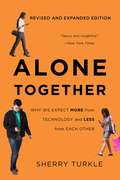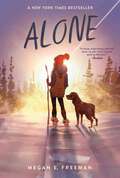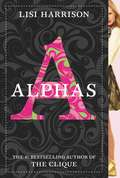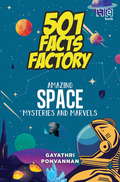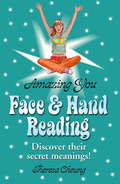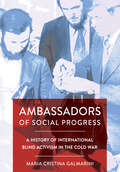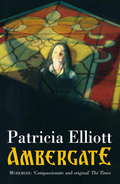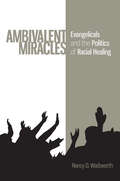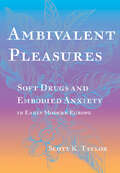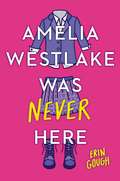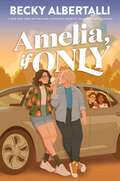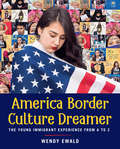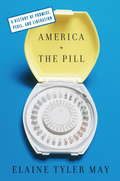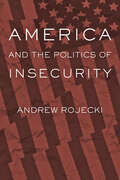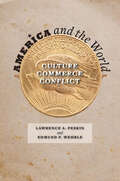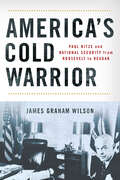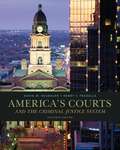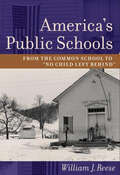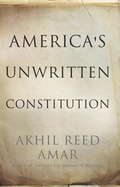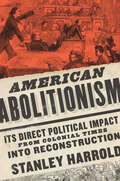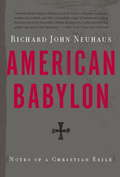- Table View
- List View
Alone Together: Why We Expect More from Technology and Less from Each Other
by Sherry TurkleConsider Facebook—it’s human contact, only easier to engage with and easier to avoid. Developing technology promises closeness. Sometimes it delivers, but much of our modern life leaves us less connected with people and more connected to simulations of them.In Alone Together, MIT technology and society professor Sherry Turkle explores the power of our new tools and toys to dramatically alter our social lives. It’s a nuanced exploration of what we are looking for—and sacrificing—in a world of electronic companions and social networking tools, and an argument that, despite the hand-waving of today’s self-described prophets of the future, it will be the next generation who will chart the path between isolation and connectivity.
Alone Together: Why We Expect More from Technology and Less from Each Other
by Sherry TurkleConsider Facebook--it's human contact, only easier to engage with and easier to avoid. Developing technology promises closeness. Sometimes it delivers, but much of our modern life leaves us less connected with people and more connected to simulations of them. In Alone Together, MIT technology and society professor Sherry Turkle explores the power of our new tools and toys to dramatically alter our social lives. It's a nuanced exploration of what we are looking for--and sacrificing--in a world of electronic companions and social networking tools, and an argument that, despite the hand-waving of today's self-described prophets of the future, it will be the next generation who will chart the path between isolation and connectivity.
Alone: Poems By Megan E. Freeman (Alone)
by Megan E. FreemanA New York Times bestseller! Perfect for fans of Hatchet and the I Survived series, this harrowing middle grade debut novel-in-verse from a Pushcart Prize–nominated poet tells the story of a young girl who wakes up one day to find herself utterly alone in her small Colorado town.When twelve-year-old Maddie hatches a scheme for a secret sleepover with her two best friends, she ends up waking up to a nightmare. She&’s alone—left behind in a town that has been mysteriously evacuated and abandoned. With no one to rely on, no power, and no working phone lines or internet access, Maddie slowly learns to survive on her own. Her only companions are a Rottweiler named George and all the books she can read. After a rough start, Maddie learns to trust her own ingenuity and invents clever ways to survive in a place that has been deserted and forgotten. As months pass, she escapes natural disasters, looters, and wild animals. But Maddie&’s most formidable enemy is the crushing loneliness she faces every day. Can Maddie&’s stubborn will to survive carry her through the most frightening experience of her life?
Alphas (Alphas #1)
by Lisi HarrisonAt OCD the losers are tormented. At Alpha Academy, they're sent home. Skye Hamilton has scored an invitation to the ultra-exclusive Alphas-only boarding school where beta is spelled LBR . What happens when the country's best, brightest, and hawtest begin clawing and scratching their way to the top?
Always Be My Bibi
by Priyanka TaslimClueless meets Jenna Evans Welch in this young adult rom-com about a spoiled American teenager who faces some major culture shock—and potential romance—when she jets off to Bangladesh for her sister&’s wedding.Bibi Hossain was supposed to get her first kiss this summer. Too bad her father finds out and grounds her for breaking his most arcane rule: No boys until your sister gets married. Just when Bibi thinks she&’ll be stuck helping him at their popular fried chicken chain until school reopens, her oh-so-perfect older sister Halima drops a bombshell: she&’s marrying the heir of a princely estate turned tea garden in Bangladesh. Soon, Bibi is hopping on the next flight to Sylhet for Halima&’s Big Fat Bengali Wedding, hoping Abbu might even rethink the dating ban while they&’re there. Unfortunately, the stuffy Rahmans are a nightmare—especially Sohel, the groom&’s younger brother. The only thing they can agree on is that their siblings are not a good match. But as the two scheme to break their siblings up, Bibi finds it impossible to stay away from the infuriatingly handsome boy. Could her own happily ever after be brewing even as she stirs up trouble for her sister&’s engagement—or is there more steeping at the tea estate than Bibi knows?
Always Isn't Forever
by J. C. CervantesFrom New York Times bestselling author J.C. Cervantes comes a sparkling, unforgettable YA romance, perfect for fans of You&’ve Reached Sam.Best friends and soul mates since they were kids, Hart Augusto and Ruby Armenta were poised to take on senior year together when Hart tragically drowns in a boating accident. Absolutely shattered, Ruby struggles to move on from the person she knows was her forever love.Hart can&’t let go of Ruby either…. Due to some divine intervention, he&’s offered a second chance. Only it won&’t be as simple as bringing him back to life—instead, Hart&’s soul is transferred to the body of local bad boy.When Hart returns to town as Jameson, he realizes that winning Ruby back will be more challenging than he&’d imagined. For one, he&’s forbidden from telling Ruby the truth. And with each day he spends as Jameson, memories of his life as Hart begin to fade away.Though Ruby still mourns Hart, she can&’t deny that something is drawing her to Jameson. As much as she doesn&’t understand the sudden pull, it can&’t be ignored. And why does he remind her so much of Hart? Desperate to see if the connection she feels is real, Ruby begins to open her heart to Jameson—but will their love be enough to bridge the distance between them?
Always Jane
by Jenn BennettA chauffer&’s daughter finds herself in the middle of a love triangle with the sons of her boss&’s wealthy next-door neighbors in this delightfully romantic story from the author of Alex, Approximately, Jenn Bennett.Love—and Fen Sarafian—do not care about your summer plans. Eighteen-year-old chauffeur&’s daughter Jane Marlow grew up among the domestic staff of a wealthy LA rock producer, within reach of bands she idolizes, but never a VIP. Every summer, Jane and her father head to the Sierras to work at the producer&’s luxury lodge at Lake Condor—a resort town and the site of a major musical festival. The legendary family who runs the festival are the Sarafians, and Jane&’s had a longtime crush on their oldest son, Eddie—doltish but sweet. So, when a long-distance romance finally sparks between them, she doesn&’t hesitate to cross class lines. But Jane&’s feelings for Eddie are thrown into question after she returns to the lake and reconnects with his alluringly intense brother, the dark horse of her placid summer plans. A fellow lover of music—and hater of the game—Fen Sarafian has been ousted from the family and is slumming it at a vinyl record shop. He burns for Jane like a house on fire and will do anything to sabotage his older brother, even if it means taking a wrecking ball to a multi-million-dollar music festival. Or Jane&’s heart.
Amazing Space Mysteries and Marvels
by Gayathri Ponvannan• It rains diamonds on Saturn. And on Jupiter. And on Neptune too! • A comet once fell into the sun…and came out of the other side!• Some stars turn into black holes! Humans have been gazing at the skies for ages, trying to figure out just what lies beyond us. Over the years, we have calculated the speed of light, the brightness of stars and the size of galaxies. We have landed spacecraft on our moon and on Saturn’s moon too. We have even sent probes that are currently travelling beyond the solar system, complete with messages for aliens! From the Big Bang to the Big Freeze, from the greatest theories to the weirdest mistakes, from the far reaches of the universe to our closest celestial neighbours, Amazing Space Mysteries and Marvels covers stars, moons, planets, comets, asteroids, meteors, galaxies, black holes and many more out-of-the-world topics that will make you go ‘ooh’ and ‘aah’! With bite-sized information and photographs, this well-researched book is perfect for aspiring astronauts and anybody curious about the mysteries of the universe. What are you waiting for? Step into the 501 Facts Factory for a spectacular journey through space.
Amazing You: Face and Hand Reading
by Theresa Cheung"I've always hated my nose. The way it looks, and the fact that it's so big. When I was little I'd do drawings of smiling faces with no noses. My parents and teachers would always remind me to draw the nose, but I never did. The way I see my nose has changed since I started face reading. If only I'd known sooner that having a long nose is pretty cool." - Sarah, 12You can learn the most amazing things by simply using your face and hands (and a little help from this book). You see faces everyday but do you really look at them? Face reading helps you to analyse every feature, line and shape and work out what they say about your personality, relationships and future destiny. Hand reading, or palmistry, is another brilliant way to find out all about you and your friends and family. By looking at your whole hand, fingers and thumbs, and lines on your palms you'll see just how useful and informative hand reading can be in your everyday life. Face and Hand Reading shows you how you can change your life by discovering just how incredible and unique you are. It is part of our stunning new Mind Body Spirit series for teenage girls - Amazing You.
Ambassadors of Social Progress: A History of International Blind Activism in the Cold War (NIU Series in Slavic, East European, and Eurasian Studies)
by Maria Cristina GalmariniAmbassadors of Social Progress examines the ways in which blind activists from the Soviet Union and Eastern Europe entered the postwar international disability movement and shaped its content and its course. Maria Cristina Galmarini shows that the international work of socialist blind activists was defined by the larger politics of the Cold War and, in many respects, represented a field of competition with the West in which the East could shine. Yet, her study also reveals that socialist blind politics went beyond propaganda. When socialist activists joined the international blind movement, they initiated an exchange of experiences that profoundly impacted everyone involved. Not only did the international blind movement turn global disability welfare from philanthropy to self-advocacy, but it also gave East European and Soviet activists a new set of ideas and technologies to improve their own national movements. By analyzing the intersection of disability and politics, Ambassadors of Social Progress enables a deeper, bottom-up understanding of cultural relations during the Cold War. Galmarini significantly contributes to the little-studied history of disability in socialist Europe, and ultimately shows that disability activism did not start as an import from the West in the post-1989 period, but rather had a long and meaningful tradition that was rooted in the socialist system of welfare and needed to be reinvented when this system fell apart.
Ambergate
by Patricia ElliottI am the girl with no name ... I have a secret I must never tell. If I do, they will come after me - the Protector and his men.Only a number branded on her arm betrays the orphan girl's past. When she arrives at Murkmere Hall to be a kitchen maid, they call her Scuff, and little guess she has committed a terrible crime. Haunted by her dark secret, all Scuff can do is pray to the divine beings - the birds - for forgiveness.Now, five years later, the past is catching up with Scuff. Hunted from all sides, she flees Murkmere, only to be forced back to the cruel confines of the Capital, and the Orphans' Home where it all began.Set in the capital city, this has a very different feel from Murkmere, but is still grounded in the bird tradition, superstition and religion that haunts the first book.
Ambivalent Miracles: Evangelicals and the Politics of Racial Healing (Race, Ethnicity, and Politics)
by Nancy D. WadsworthOver the past three decades, American evangelical Christians have undergone unexpected, progressive shifts in the area of race relations, culminating in a national movement that advocates racial integration and equality in evangelical communities. The movement, which seeks to build cross-racial relationships among evangelicals, has meant challenging well-established paradigms of church growth that built many megachurch empires. While evangelical racial change (ERC) efforts have never been easy and their reception has been mixed, they have produced meaningful transformation in religious communities. Although the movement as a whole encompasses a broad range of political views, many participants are interested in addressing race-related political issues that impact their members, such as immigration, law enforcement, and public education policy. Ambivalent Miracles traces the rise and ongoing evolution of evangelical racial change efforts within the historical, political, and cultural contexts that have shaped them. Nancy D. Wadsworth argues that the stunning breakthroughs this movement has achieved, its curious political ambivalence, and its internal tensions are products of a complex cultural politics constructed at the intersection of U.S. racial and religious history and the meaning-making practices of conservative evangelicalism. Employing methods from the emerging field of political ethnography, Wadsworth draws from a decade’s worth of interviews and participant observation in ERC settings, textual analysis, and survey research, as well as a three-year case study, to provide the first exhaustive treatment of ERC efforts in political science. A 2014 CHOICE Outstanding Academic Title
Ambivalent Pleasures: Soft Drugs and Embodied Anxiety in Early Modern Europe
by Scott K. TaylorAmbivalent Pleasures explores how Europeans wrestled with the novel experience of consuming substances that could alter moods and become addictive. During the early modern period, psychotropic drugs like sugar, chocolate, tobacco, tea, coffee, distilled spirits like gin and rum, and opium either arrived in western Europe for the first time or were newly available as everyday commodities. Drawing from primary sources in English, Dutch, French, Italian, and Spanish, Scott K. Taylor shows that these substances embodied Europeans' anxieties about race and empire, religious strife, shifting notions of class and gender roles, and the moral implications of urbanization and global trade.Through the writings of physicians, theologians, political pamphleteers, satirists, and others, Ambivalent Pleasures tracks the emerging understanding of addiction; fears about the racial, class, and gendered implications of using these soft drugs (including that consuming them would make users more foreign); and the new forms of sociability that coalesced around their use. Even as Europeans' moral concerns about the consumption of these drugs fluctuated, the physical and sensory experiences of using them remained a critical concern, anticipating present-day rhetoric and policy about addiction to drugs and alcohol.
Amelia Westlake Was Never Here
by Erin GoughA fiercely funny, queer romantic comedy about two girls who can't stand each other, but join forces in a grand feminist plan to expose harassment and inequality at their elite private school.Harriet Price is the perfect student: smart, dutiful, over-achieving. Will Everhart is a troublemaker who's never met an injustice she didn't fight. When their swim coach's inappropriate behavior is swept under the rug, the unlikely duo reluctantly team up to expose his misdeeds, pulling provocative pranks and creating the instantly legendary Amelia Westlake--an imaginary student who helps right the many wrongs of their privileged institution. But as tensions burn throughout their school--who is Amelia Westlake?--and between Harriet and Will, how long can they keep their secret? How far will they go to make a difference? And when will they realize they're falling for each other?Award-winning author Erin Gough's Amelia Westlake Was Never Here is a funny, smart, and all-too-timely story of girls fighting back against power and privilege--and finding love while they're at it.
Amelia, If Only
by Becky AlbertalliAmelia Applebaum isn’t in love with Walter Holland. He just happens to be her favorite moderately famous, chaotically bisexual YouTuber. Who she just happened to invite to prom. (But it’s fine. No, for real. If you delete the post, it didn’t happen.)Okay, maybe her friends are right: She’s slightly parasocially infatuated. But Amelia just knows sparks would fly—if only she could connect with Walter for real. If only he would host a meet and greet. If only it were just a short road trip away. And if only Amelia could talk her best friends into making it the perfect last hurrah before graduation—even her newly single, always-cynical, guitar-toting best friend Natalie.One thing’s for sure: All roads lead to butterflies.But what if Amelia’s butterflies aren’t for Walter at all?
America Border Culture Dreamer: The Young Immigrant Experience from A to Z
by Wendy EwaldFirst- and second-generation immigrants to the US from all around the world collaborate with renowned photographer Wendy Ewald to create a stunning, surprising catalog of their experiences from A to Z. In a unique collaboration with photographer and educator Wendy Ewald, eighteen immigrant teenagers create an alphabet defining their experiences in pictures and words. Wendy helped the teenagers pose for and design the photographs, interviewing them along the way about their own journeys and perspectives.America Border Culture Dreamer presents Wendy and the students' poignant and powerful images and definitions along with their personal stories of change, hardship, and hope. Created in a collaboration with Al-Bustan Seeds of Culture, this book casts a new light on the crucial, under-heard voices of teenage immigrants themselves, making a vital contribution to the timely national conversation about immigration in America.
America and the Pill: A History of Promise, Peril, and Liberation
by Elaine Tyler MayIn 1960, the FDA approved the contraceptive commonly known as "the pill. ” Advocates, developers, and manufacturers believed that the convenient new drug would put an end to unwanted pregnancy, ensure happy marriages, and even eradicate poverty. But as renowned historian Elaine Tyler May reveals in America and the Pill, it was women who embraced it and created change. They used the pill to challenge the authority of doctors, pharmaceutical companies, and lawmakers. They demonstrated that the pill was about much more than family planning-it offered women control over their bodies and their lives. From little-known accounts of the early years to personal testimonies from young women today, May illuminates what the pill did and did not achieve during its half century on the market.
America and the Politics of Insecurity (Themes in Global Social Change)
by Andrew RojeckiAn innovative analysis of polarized politics post-9/11.In America and the Politics of Insecurity, Andrew Rojecki assesses the response of citizens and politicians to a series of crises that confronted the United States during the first decade of the twenty-first century. This period brought Americans face to face with extraordinarily difficult problems that were compounded by their origin in seemingly uncontrollable global forces. Rojecki establishes a theoretical framework for understanding how these new uncertainties contribute to increasingly polarized political discourse. Analyzing three domains of American insecurity—economic, environmental, and existential—Rojecki examines responses to the Great Recession by groups like the Tea Party and Occupy Wall Street; considers why the growing demand for fossil fuels makes people disregard global warming; and explores the desire for security measures that restrict personal freedom in the age of terrorism. Ultimately, he explains why the right has thus far held an edge over the left in the politics of insecurity.Rojecki concludes that in order to address these broad-scale political problems, we must reframe domestic issues as reactions to undiagnosed global conditions. Bringing the psychology of uncertainty together with contemporary case studies, this book is a sweeping diagnostic for—and antidote to—ineffective political discourse in a globalized world that imports bads as well as goods.
America and the World: Culture, Commerce, Conflict
by Edmund F. Wehrle Lawrence A. PeskinAlthough the twenty-first century may well be the age of globalization, this book demonstrates that America has actually been at the cutting edge of globalization since Columbus landed here five centuries ago.Lawrence A. Peskin and Edmund F. Wehrle explore America's evolving connections with Europe, Africa, and Asia in the three areas that historically have been indicators of global interaction: trade and industry, diplomacy and war, and the "soft" power of ideas and culture. Framed in four chronological eras that mark phases in the long history of globalization, this book considers the impact of international events and trends on the American story as well as the influence America has exerted on world developments. Peskin and Wehrle discuss how the nature of this influence—whether economic, cultural, or military—fluctuated in each period. They demonstrate how technology and disease enabled Europeans to subjugate the New World, how colonial American products transformed Europe and Africa, and how post-revolutionary American ideas helped foment revolutions in Europe and elsewhere. Next, the authors explore the American rise to global economic and military superpower—and how the accumulated might of the United States alienated many people around the world and bred dissent at home. During the civil rights movement, America borrowed much from the world as it sought to address the crippling "social questions" of the day at the same time that Americans—especially African Americans—offered a global model for change as the country strove to address social, racial, and gender inequality. Lively and accessible, America and the World draws on the most recent scholarship to provide a historical introduction to one of today's vital and misunderstood issues.
America's Cold Warrior: Paul Nitze and National Security from Roosevelt to Reagan
by James Graham WilsonIn America's Cold Warrior, James Graham Wilson traces Paul Nitze's career path in national security after World War II, a time when many of his mentors and peers returned to civilian life. Serving in eight presidential administrations, Nitze commanded White House attention even when he was out of government, especially with his withering criticism of Jimmy Carter during Carter's presidency. While Nitze is perhaps best known for leading the formulation of NSC-68, which Harry Truman signed in 1950, Wilson contends that Nitze's most significant contribution to American peace and security came in the painstaking work done in the 1980s to negotiate successful treaties with the Soviets to reduce nuclear weapons while simultaneously deflecting skeptics surrounding Ronald Reagan. America's Cold Warrior connects Nitze's career and concerns about strategic vulnerability to the post-9/11 era and the challenges of the 2020s, where the United States finds itself locked in geopolitical competition with the People's Republic of China and Russia.
America's Courts And The Criminal Justice System
by David W. Neubauer Henry F. FradellaOpen this book and step into America's court system! With Neubauer and Fradella's best seller, you will see for yourself what it is like to be a judge, a prosecutor, a defense attorney, and more. This fascinating and well-researched book gives you a realistic sense of being in the courthouse, enabling you to quickly gain an understanding of what it is like to work in and be a part of the American criminal justice system. The book's approach, which focuses on the courthouse "players," makes it easy to understand each person's important role in bringing a case through the court process. Throughout the book, the authors highlight not only the pivotal role of the criminal courts but also the court's importance and impact on society as a whole.
America's Public Schools: From the Common School to "No Child Left Behind" (The American Moment)
by William J. ReeseIn this update to his landmark publication, William J. Reese offers a comprehensive examination of the trends, theories, and practices that have shaped America’s public schools over the last two centuries. Reese approaches this subject along two main lines of inquiry—education as a means for reforming society and ongoing reform within the schools themselves. He explores the roots of contemporary educational policies and places modern battles over curriculum, pedagogy, race relations, and academic standards in historical perspective.A thoroughly revised epilogue outlines the significant challenges to public school education within the last five years. Reese analyzes the shortcomings of "No Child Left Behind" and the continued disjuncture between actual school performance and the expectations of government officials. He discusses the intrusive role of corporations, economic models for enticing better teacher performance, the continued impact of conservatism, and the growth of home schooling and charter schools. Informed by a breadth of historical scholarship and based squarely on primary sources, this volume remains the standard text for future teachers and scholars of education.
America's Unwritten Constitution: The Precedents and Principles We Live By
by Akhil Reed AmarDespite its venerated place atop American law and politics, our written Constitution does not enumerate all of the rules and rights, principles and procedures that actually govern modern America. The document makes no explicit mention of cherished concepts like the separation of powers and the rule of law. On some issues, the plain meaning of the text misleads. For example, the text seems to say that the vice president presides over his own impeachment trial-but surely this cannot beright. As esteemed legal scholar Akhil Reed Amar explains inAmerica’s Unwritten Constitution, the solution to many constitutional puzzles lies not solely within the written document, but beyond it-in the vast trove of values, precedents, and practices that complement and complete the terse text. In this sequel toAmerica’s Constitution: A Biography, Amar takes readers on a tour of our nation’sunwrittenConstitution, showing how America’s foundational document cannot be understood in textual isolation. Proper constitutional interpretation depends on a variety of factors, such as the precedents set by early presidents and Congresses; common practices of modern American citizens; venerable judicial decisions; and particularly privileged sources of inspiration and guidance, including theFederalistpapers, William Blackstone’sCommentaries on the Laws of England, the Northwest Ordinance of 1787, Lincoln’s Gettysburg Address, and Martin Luther King, Jr. ’s "I Have a Dream” speech. These diverse supplements are indispensible instruments for making sense of the written Constitution. When used correctly, these extra-textual aids support and enrich the written document without supplanting it. An authoritative work by one of America’s preeminent legal scholars,America’s Unwritten Constitutionpresents a bold new vision of the American constitutional system, showing how the complementary relationship between the Constitution’s written and unwritten components is one of America’s greatest and most enduring strengths.
American Abolitionism: Its Direct Political Impact from Colonial Times into Reconstruction (A Nation Divided)
by Stanley HarroldThis ambitious book provides the only systematic examination of the American abolition movement’s direct impacts on antislavery politics from colonial times to the Civil War and after. As opposed to indirect methods such as propaganda, sermons, and speeches at protest meetings, Stanley Harrold focuses on abolitionists’ political tactics—petitioning, lobbying, establishing bonds with sympathetic politicians—and on their disruptions of slavery itself.Harrold begins with the abolition movement’s relationship to politics and government in the northern American colonies and goes on to evaluate its effect in a number of crucial contexts--the U.S. Congress during the 1790s, the Missouri Compromise, the struggle over slavery in Illinois during the 1820s, and abolitionist petitioning of Congress during that same decade. He shows how the rise of "immediate" abolitionism, with its emphasis on moral suasion, did not diminish direct abolitionists’ impact on Congress during the 1830s and 1840s. The book also addresses abolitionists’ direct actions against slavery itself, aiding escaped or kidnapped slaves, which led southern politicians to demand the Fugitive Slave Law of 1850, a major flashpoint of antebellum politics. Finally, Harrold investigates the relationship between abolitionists and the Republican Party through the Civil War and Reconstruction.
American Babylon: Notes of a Christian Exile
by Richard John NeuhausChristians are by their nature a people out of place. Their true home is with God; in civic life, they are alien citizens "in but not of the world. " InAmerican Babylon, eminent theologian Richard John Neuhaus examines the particular truth of that ambiguity for Catholics in America today. Neuhaus addresses the essential quandaries of Catholic life-assessing how Catholics can keep their heads above water in the sea of immorality that confronts them in the world, how they can be patriotic even though their true country is not in this world, and how they might reconcile their duties as citizens with their commitment to God. Deeply learned, frequently combative, and always eloquent,American Babylonis Neuhaus'smagnum opus-and will be essential reading for all Christians.
